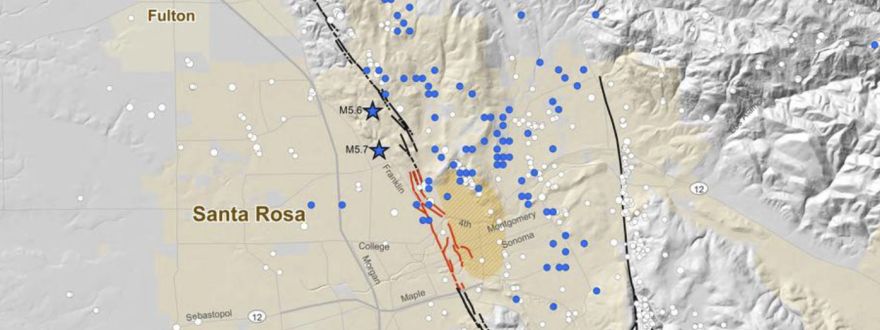
Were you woken up by that earthquake this morning!? We certainly were! Did you know Santa Rosa actually has a fault beneath it that's approximately one-quarter mile wide one mile long? Dubbed the Rodgers Creek Fault, until recently its exact location was obscured by urban development. In the image above, the fault is visble as the red lines just east of downtown Santa Rosa.
For the first time, scientists at the U.S. Geological Survey have mapped the active surface trace of the Rodgers Creek Fault through the central part of the northern California city of Santa Rosa. Knowing where the fault reaches the ground surface and the total width of the zone of faulting are important for assessing the hazard from surface rupture in a large earthquake. “We used detailed topographic imagery from airborne lidar and subsurface imaging from high-resolution geophysical surveys to trace the fault through Santa Rosa,” said USGS geologist Suzanne Hecker, lead author of the study.
The zone of faulting at the surface is broader and covers an area that extends farther east than previously assumed, which means the surface-rupture hazard is more widespread than previously thought. There are subtle fault “scarps” (the vertical scars left on the landscape from fault motion) on the gently-sloping floodplain of Santa Rosa Creek, on which the city is built, that define a surface depression that is one-quarter-mile wide by one-mile long.
On the basis of the lidar and geophysical observations, and preliminary data from previous studies suggesting a change in the rate of surface creep on the fault in the vicinity of Santa Rosa, USGS scientists speculate that the dense, magnetic body of rock may be a stuck patch, or “asperity,” on the fault, where stress concentrates. A large earthquake on the Rodgers Creek Fault that ruptures through the proposed asperity has the potential to intensely shake the sedimentary basin beneath Santa Rosa. This basin is already known, from an earlier study of the damaging 1969 Santa Rosa and 1906 San Francisco earthquakes, to amplify shaking at the ground surface. The Rodgers Creek Fault is thought to be among the most likely faults to produce the next large earthquake in the Bay Area.





